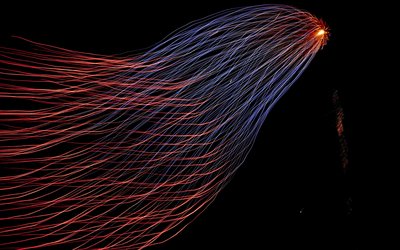Current trends in data transfer have asserted that big cities—cities of business, culture, and innovation—need intercapital dedicated wavelength connectivity of a very high capacity for fast sending and receiving of data. Strong private optical communications allow everything from cloud computing to working in real-time across countries to convincing financial trading. These enormous flows of data have a little-known and often ignored companion—the submarine cables. The fibre optic lines are secretively submerged beneath the ocean; they form the unseen highways of the global digital economy. Their presence allows for very fast and reliable communication, which is the lifeblood of modern existence.
The Indispensable Role of Submarine Cables in Global Connectivity
The Backbone of Intercontinental Data Flow
Submarine cables are the most significant part of the infrastructures that connect businesses across the world. They make up more than 95% of the international internet and data traffic. There is often a blank spread, as people tend to think of satellites as the main mode of data transmission; in fact, they send a very small amount of data. And that's because, for speed, capacity, and reliability, which are all required by an enterprise today, no kind of connection can beat underwater fibre optic cables.
Thousands of kilometres of these cables stretch into the sea and link big business and financial capitals, such as Sydney, Singapore, London, New York, Tokyo, and Los Angeles. It brings into effect what can be termed high-capacity intercapital wavelength services suitable for real-time trading, cloud usage, high-definition video conferencing, and massive secure data exchange. Today, in the digital economy, international cabling actually connects continents but also connects the global business.
Unmatched Capacity and Speed Over Long Distances
Today's fast-paced, data-hungry global economy demands undersea cables, which are technological marvels. Systems are made up of three or more fibre pairs combined with the latest Optical technologies such as Dense Wavelength Division Multiplexing DWDM.
For example, the INDIGO cable system, launched in 2019, connects Sydney, Perth, Singapore, and Jakarta with dual fibre pairs and a design capacity of up to 36 Tbps per pair. Spanning over 9,000 kilometres, INDIGO plays a key role in linking Australia to key economic hubs in Asia and supports growing demand for low-latency, high-bandwidth connectivity in the region. Newer systems landing in Australia, such as Hawaiki Nui and OMC, continue this trend, offering scalable capacities in the hundreds of terabits per second.
Undersea repeaters complement the optical amplification of undersea cables across the oceans. Therefore, high-quality transmission is always expected to take place via the oceans. In addition, they are very important because they have a latency that is much lower than that of satellites orbiting tens of thousands of kilometres above Earth, so they are faster and bigger than other things.
Empowering Intercapital Wavelengths Across Oceans
Extending Dedicated Optical Paths Globally
Submarine cables are the virtually invisible threads that bind the fabric of the global digital infrastructure together. They facilitate the extension of intercapital wavelength services—dedicated high-bandwidth optical connections—between the major business hubs and the national capitals on the continents. These low-latency and high-capacity links form the first layer of international wavelength services, providing extremely high-performance requirements for enterprise workloads.
Submarine cables provide a secure and private connection remote from congested public internet paths—whether a multinational is linking data centres in Frankfurt and Singapore or a hyperscaler is scaling its footprint across Asia-Pacific. By provisioning optical wavelengths end-to-end, organisations will have more control over performance, security, and reliability.
These services support technologies such as Ethernet, OTN, and fibre channels with scalable bandwidths up to 400 Gbps per wavelength and beyond. This enables global businesses to process massive volumes of data quickly and efficiently from real-time analytics, cloud interconnects, remote media production, and financial transactions.
Enhancing Network Resilience and Redundancy
The submarine cable networks are built for resilience, which is equally crucial for global connectivity. These systems are established with varying landing sites and routes to span multiple geographies over continents. The backup systems mean that if there is a problem on one part, whether from a natural disaster, an anchor hitting it, or accidental damage, data can be redirected through other routes with minimal downtime.
On the international intercapital wavelength connectivity, such resilience is no longer a feature but rather a strategic requirement. Telecommunication carriers, hyperscalers, and companies count on this kind of toughness to fulfil their service level agreements and avoid the loss of data while ensuring real-time, uninterrupted performance for work that is critical to them. Thus, both governments and non-governmental parties pour huge amounts into the safety and monitoring of these underwater devices, realising that the failure of one cable can have ripple effects on digital infrastructure nationally and globally.
What remains unyielding for global submarine cable redundancy is what motivates the digital economy—be it natural or man-made calamities.
Impact on Data-Intensive Industries and Future Global Trends
Enabling Global Business Operations and Cloud Expansion
With the increase in cloud adoption and the rising prevalence of global businesses, these cables have continued to meet the demand for extremely high capacity and reliable intercontinental connectivity. Forming the very core of international operations, submarine cables are key to enterprises, financial institutions, media houses, and giant cloud service providers.
This is how public cloud platforms like AWS, Microsoft Azure, or Google Cloud rely on these high-capacity, low-latency fibre optic networks to ramp up services in new countries, replicate workloads across continents, and build seamless multi-region architectures. Wavelength services run over submarine cables for ensuring secure, high-performance connectivity on mission-critical applications.
Ultra-low-latency connections between global stock exchanges allow for high-frequency trading and instant settlement in finance. Real-time collaboration occurs between teams in media and entertainment across borders via the sharing of massive 4K video files, raw assets, and live production data. Large underwater cables can also support remote work, this includes collaboration for scientific research, cross-border cloud migration, disaster recovery services, and many other essential services.
Future-Proofing Global Interconnectivity for Emerging Technologies
With the advent of AI, IoT, and an enhanced experience of immersiveness in digital environments, the demand for data capacity in the world will become increasingly urgent. The infrastructure designed to globally scale and hold resilient capacity has only to do with generating large-scale machine learning models, streaming high-resolution virtual reality content, and transferring data from billions of IoT sensors.
To utilise all of this potential and increase the people's appetite for bandwidth, the new generation of submarine cables is a joint investment by tech consortia, governments, and telecom providers. Innovations such as transocean high-fibre-count cables are destined to increase capacity while reducing cost per bit. In-service upgrades to cable systems, such as coherent optics-induced improvements, will push up the existing boundaries of application reach over current fibre.
These are the innovations that will make sure international wavelength services continue to be valuable and scalable as our collective appetite for bandwidth keeps growing.
They are invisible but indispensable. Submarine cables are the backbones of the digital world. They quietly power the global exchange of information, commerce, and collaboration, far beyond being wires beneath the sea. They are the backbone of intercapital wavelength connectivity, delivering capacity, speed, and resilience for today's most demanding applications, including real-time trading and media production, cloud expansion, and international enterprise operations.
Further investing in submarine cable infrastructure thus becomes not merely a strategic move but an imperative since reliance on digital means deepens and emerging technologies drive data traffic to exponential proportions. From here, these underwater lifelines will continue enabling most of the innovation, competitiveness, and worldwide presence.
Whether you are a company with ambitions to globalise, a cloud provider scaling across regions, or a policymaker wanting to shape the future of digitally connected infrastructure—know: the future of global connectivity runs through oceans.
Stay connected. Stay global. Trust in the networks beneath the waves.
Are you ready to reinvent your connectivity?
Contact the Nexthop Team for further information. Count on it, and let's explore how much our wavelength services could support your organisation's global ambitions.





